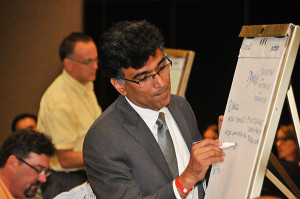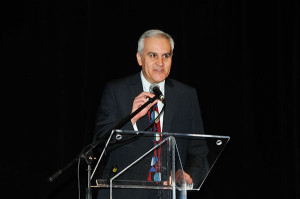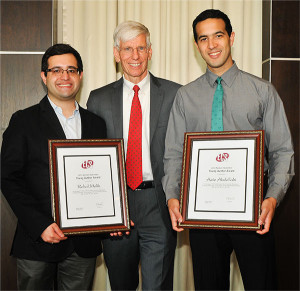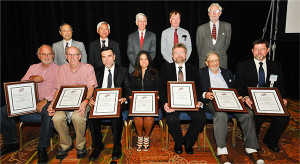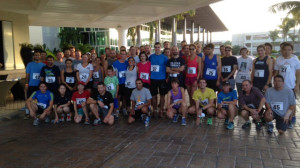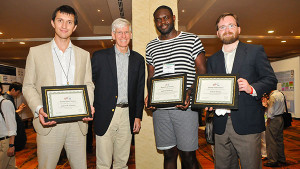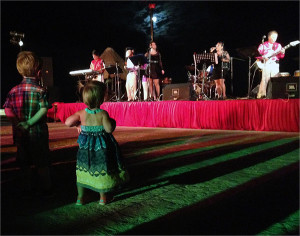Cancun was my second meeting. What I’ve noticed so far is how giving everyone is. Total strangers, some very important ones, have been more than willing to share their science or help me understand the inner-workings of the Society. The meetings feel like safe places where I can ask stupid questions and be vulnerable. Which, they say, is the birthplace of innovation, creativity and change. (After you’ve read the highlights, go watch Brene Brown’s TED Talk on The Power of Vulnerability. She has the research!)
Over 2,000 people attended the 2014 ECS and SMEQ Joint International Meeting in Cancun, Mexico. This was ECS’s first return visit to Cancun since 2006. Participants could choose among 51 symposia and 2,299 presentations.
(Look for photos on Facebook.)
Electrochemical Energy and Water Summit
In its first “Science for Solving Society’s Problems Challenge,” ECS partnered with the Bill & Melinda Gates Foundation to leverage the brainpower of the many scientists in electrochemistry and solid state science and technology that regularly attend ECS meetings. The four grantees were identified during a multi-day workshop. Over 100 researchers were guided through a brainstorming and working group session with the theme of improving access to clean water and sanitation in developing countries. The winners:
- Artificial Biofilms for Sanitary/Hygienic Interface Technologies (A-Bio SHIT)
Plamen Atanassov, University of New Mexico, $70,000
Interfaces: Produce bio-catalytic septic cleaning materials that incorporate microorganisms removing organic and inorganic contaminants, while simultaneously creating electricity (or hydrocarbon fuel) for energy generation in support of a sustainable and portable system. - In-situ Electrochemical Generation of the Fenton Reagent for Wastewater Treatment
Luis Godinez, Centro de Investigacion y Desarrollo Tecnologico en Electroquimica SC, Mexico, $50,000
Disinfection: Study the electro-Fenton approach using activated carbon to efficiently oxidize most of the organic and biological materials present in sanitary wastewater so that recycling of the wastewater might be possible. - powerPAD
Neus Sabate, Institut de Microelectrónica de Barcelona (CSIC); Juan Pablo Esquivel, University of Washington; Erik Kjeang, Simon Fraser University, $50,000
Monitoring and Measurement: Develop a non-toxic portable source of power for water measuring and monitoring systems, which will not require recycling facilities. Using inexpensive materials such as paper, nanoporous carbon electrodes and organic redox species, the team will strive to create a biodegradable and even compostable power source. - More than MERe Microbes: Microbial Electrochemical Reactors for Water Reuse in Africa
Gemma Reguera, Michigan State University, $40,000
Chemical Conversion: Develop microbial electrochemical reactors that harvest energy from human waste substrates using bioanodes engineered to process the waste into biofuels while simultaneously cleaning water for reuse. The microbial catalysts will be selected for their efficiency at processing the wastes, but also for their versatility to process other residential and agricultural waste substrates. This will provide an affordable, easy to operate system for the decentralized processing of a wide range of wastes for improved sanitation, water reuse, and energy independence.
Plenary session
Facundo Almeraya Calderón, President of Sociedad Mexicana de Electroquimica, welcomed everyone on behalf of SMEQ and ECS, noting that over 2,000 attendees were on hand for this the 226th meeting of ECS, the 7th meeting of the ECS Mexico Section, and the 29th Congreso for SMEQ. ESC President Paul Kohl also welcomed the crowd and was the master of ceremonies for the awards presentations, which included 10 different awards and 41 winners.
The ECS Lecture
Advances in Science, Technology and Innovation (STI) in Mexico was the title of The ECS Lecture given by Víctor Gerardo Carreón Rodríguez, Director Adjuncto de Planección y Cooperación International. He explained how Mexico’s goal is to develop the capabilities to transition toward a knowledge-based society and economy by contributing to the growth of the national investment in STI, developing and strengthening highly qualified human resources, strengthen regional development, promoting exchange between academic research and the economic sector, strengthening scientific and technological infrastructure, and strengthen the STI capacities in biotechnology.
Award highlights
The Charles W. Tobias Young Investigator Award is given to a young scientist or engineer who has produced outstanding scientific and/or engineering work in fundamental or applied electrochemistry or solid-state science and technology. The award is named in memory of Charles Tobias, the 69th ECS President, who is considered the Father of Electrochemical Engineering.
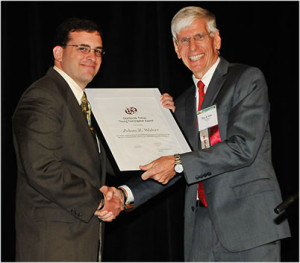
Adam Weber was their year’s Charles W. Tobias Young Investigator Award. Here with ECS President Paul Kohl.
This year’s winner was Adam Weber, staff scientist of Lawrence Berkeley National Laboratory, for his research leadership that furthered the understanding of transport in electrochemical systems through the use of mathematical modeling and advanced diagnostic techniques. Dr. Weber presented his award-winning address entitled “Understanding Transport Phenomena in Polymer-Electrolyte Fuel Cells” at the meeting.
The Edward Goodrich Acheson Award was established for distinguished contributions to the advancement of any of the objects, purposes, or activities of ECS. The 2014 Acheson Award went to Ralph Brodd, President of Broddarp. Dr. Brodd is an ECS Past President and an ECS Honorary member. Dr. Brodd was honored for his exceptional service to the Society, and for inspiring leadership in the innovation, commercialization, management, and public service activities based on the electrochemistry of batteries.
ECS has an Institutional Membership program that began almost 70 years ago. This year’s Leadership Circle Awards went to:
- Bronze Level (5 years) – Gelest Inc., Next Energy EWE-Forschunzzentrum, Asahi Kasei E-Materials Corporation, and Honda R&D Company
- Silver Level (10 years) – Lawrence Berkeley National Laboratory and ZSW
- Gold Level (25 years) – 3M Company
ECS Chapter of Excellence Awards went to the University of Maryland and the Valley of the Sun Student Chapter, which is comprised of students from several schools in central Arizona.
The Outstanding Student Chapter Award went to The University of Texas at Austin.
There were eight ECS Divisions awards:
- Battery Division Research Award was presented to Arumugam Manthiram of The University of Texas at Austin.
- Battery Division Technology Award was presented to Feng Wu of Beijing Institute of Technology.
- Battery Division Student Research Award was presented to Martin Ebner of the Swiss Federal Institute of Technology.
- Corrosion Division H. H. Uhlig Award was presented to Paul M. Natishan of the Naval Research Laboratory.
- Corrosion Division Morris Cohen Graduate Student Award was presented to Yolanda Hedberg of KTH Royal Institute of Technology.
- Electrodeposition Division Research Award was presented to Alan C. West of Columbia University.
- High Temperature Materials Division Outstanding Achievement Award was presented to Janusz Nowotny, of University of Western Sydney, Australia.
- Physical and Analytical Electrochemistry Division Max Bredig Award in Molten Salt and Ionic Liquid Chemistry was presented to Charles Logan Hussey of the University of Mississippi.
- Sensor Division Outstanding Achievement Award was presented to Peter Hesketh of the Georgia Institute of Technology.
The ECS Service Award went to both Christina Bock, for her service to ECS as Treasurer, and to Past President Tetsuya Osaka.
The Norman Hackerman Young Author Award for the best paper published in the Journal of The Electrochemical Society for a topic in the field of electrochemical science and technology went to Rahul Malik and Aziz Abdellahi for their paper, “A Critical Review of the Li Insertion Mechanisms in LiFePO4 Electrodes.”
The Bruce Deal and Andy Grove Young Author Award, newly established in 2013, was presented for the best paper published in the ECS Journal of Solid State Science and Technology, for a topic in the field of solid state science and technology by a young author to Konstantino Spyrou for his paper, “Hydrogen Storage in Graphene-Based Materials: Efforts Towards Enhance Hydrogen Absorption.”
2014 ECS Fellows
Daniel Scherson, ECS Senior Vice-President assisted with the introduction of the 2014 Class of Fellows. These members are being recognized for contributions to the advancement of science and technology, for leadership in electrochemical and solid state science and technology, and for active participation in the affairs of The Electrochemical Society:
George Blomgren: Among his major accomplishments, Blomgren helped to develop an industry leading battery for high power applications such as power tools.
Gerardine Botte: The Ohio State University professor is the inventor of 18 US patents and 29 pending applications.
Ralph J. Brodd: With over 40 years of experience in energy conversion, Brodd’s experience spans the major primary rechargeable battery systems, fuel cells, and electrochemical capacitors.
Yasuhiro Fukunaka: Was the first to observe various kinds of unique electrochemical interfacial phenomena in microgravity conditions.
Jay W. Grate: As a pioneer in the development of polymer-coated vapor sensors, Dr. Grate developed his signature contribution of a systematic understanding of vapor-polymer interactions as they relate to sensor selectivity.
Dirk M. Guldi: Regarded as one of the world-leading scientists in the field of charge transfer/nanocarbons, Professor Guldi is known for his contributions to the area of nanostructured thin films for solar energy conversion.
Bruce Parkinson: With his research covering a wide range of areas, Professor Parkinson has more than 210 publications in peer-reviewed journals and holds 5 US patents.
Fred Roozeboom: Noted for his work in Li-ion microbatteries, Dr. Roozeboom received the Bronze Award of the ‘NXP Invention of the Year 2007.’
Alvin Salkind: Dr. Salkind is most recognized for being the first to build a battery into an x-ray port tracking structure with state of charge.
Sudipta Seal: At the University of Central Florida, Dr. Seal pioneered nanostructured cerium oxide and other metal/oxide platforms.
Michael M. Thackeray: Among his many achievements, Dr. Thackeray is recognized for his contributions to the design of composite electrode structures for lithium-ion batteries.
Tooru Tsuru: Throughout his career, Professor Tsuru has helped advance corrosion research and developed understanding based on electrochemistry principles.
Harry L. Tuller: Professor Tuller has published over 420 articles, co-edited 15 books and was awarded 29 patents.
Jose H. Zagal: After being awarded the Presidential Chair in Science in 1996 in Chile by Nobel Laureate Rudolph Marcus, he was appointed member of the Superior Council of Sciences by the President of Chile.
Piotr Zelenay: Since becoming Project Leader for LANL Fuel Cell Program in 2000, Dr. Zelenay has led numerous research projects and received more than 20 awards and recognitions.
5K Run-For-Fun
The Free the Science 5K winners were Matthew Lawder and, the fastest woman finisher, Rava Mohtadi. Matthew won the race at the last meeting in Orlando, too. He plans to win in Chicago and is taking on all challengers! Proceeds from the event benefit the ECS Publications Endowment.
Student poster contest
The student poster session awards were handed out by ESC President, Paul Kohl. The winners were:
First Place, Electrochemical Science and Technology, Axel Gambou-Bosca (Université du Québec à Montréal); Daniel Belanger, adviser.
Second Place, Electrochemical Science and Technology, Miguel Angel Arellano Gonzalez (Universidad Autonoma Metropolitana Iztapalapa); Ignacio Gonzalez, Maftinez and Anne-Claire Texier, advisers.
First Place, Solid State Science and Technology, Andrew Dumey and Elizabeth Hotvedt (University of Rochester); Prof. Mukaibo, adviser.
Second Place, Solid State Science and Technology, Andrew R. Akbashev (Drexel University); Jonathan E. Spanier, adviser.
Student Mixer
More than 140 students attended a mixer Monday night thanks to the generous support of Gelest.
Cena Baile
A special dinner/dance party was held on the edge of the Gulf of Mexico on a beautiful Thursday evening. A great crowd danced the night away to a live band.
Conference Proceedings Available
All advanced ECS Transactions issues from the Cancun meeting have now been published online.
Exhibitors
Special thanks goes to all of the meeting sponsors and exhibitors, who showcased the tools and equipment so critical to scientific research.


